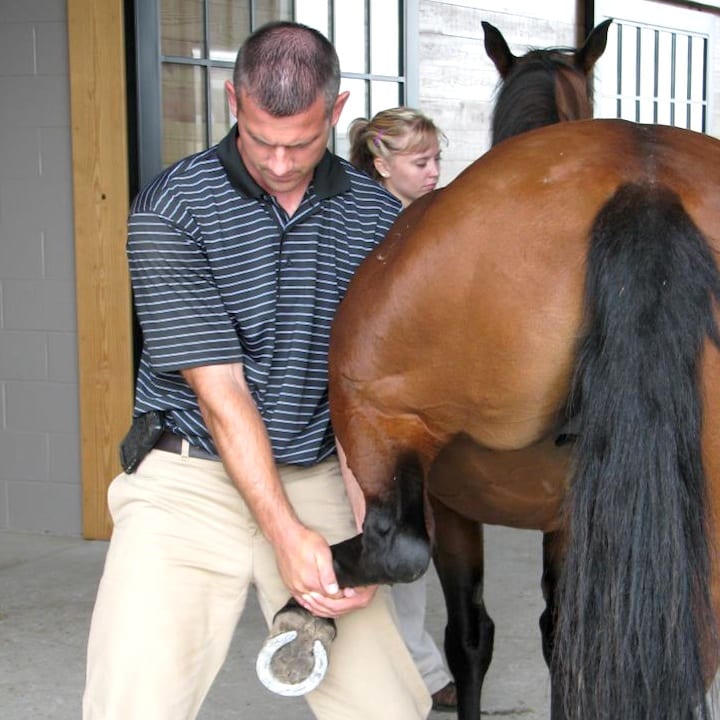Walking up to a mobile vet trailer at a horse show can be very daunting to even the most seasoned show person. The flapping tent, the scary ramp, the smell of disinfectant and the fact that your horse is in need of veterinary services can be intimidating and disheartening. Never fear; the vets are here and ready to serve you.
At a busy show like the Congress or the World Show, mobile vet clinics can see between 30 to 50 equine clients in a day. Therefore, there are some simple things that you, as an owner, trainer or exhibitor can do to make your appointment a more pleasant experience.
Dr. Jim Hassinger and Dr. Alison Roth of Hassinger Equine Sports Medicine focus their business on customer service and their desire to make their clients feel welcome. Dr. Roth smiles as she says, “We understand that this can be a stressful time for our clients. They may not understand fully what is wrong with their horse and they feel pressured with the weight of competition. It is our goal to make them feel welcomed, informed and comforted that we are providing them with the best care possible.”
Preparing for Appointment
Ground Manners
- For the vet to assess the point of lameness, a Flex-Jog test is necessary; this is where the doctor flexes a particular joint and views the horse as it trots to see if it favors a certain area of pain. If your horse is not a good at leading or is lacking basic ground manners, this can affect the accuracy of the test and can waste valuable time. Dr. Brad Cumper of Game Time Equine Sports Medicine tells us that, “Having well-mannered horses makes our job easier and believe allows for a better overall quality of treatment. With this said, most of our patients are great to work with, the trouble is usually with yearlings with minimal handling.”
Arrive On Time or Early
 It really does help if you can arrive for your appointment on time, or even better yet, five minutes early. A quick phone call to the main office can easily notify the vet if you are going to be late or if you need to cancel your appointment. During a particularly busy show, notice what is going on in and around the trailer. Also, you will have much better success if you approach the technicians and staff first. The technicians are trained to answer your questions or direct you to a vet at the appropriate time which keeps your vet on schedule and makes the entire process run much more smoothly.
It really does help if you can arrive for your appointment on time, or even better yet, five minutes early. A quick phone call to the main office can easily notify the vet if you are going to be late or if you need to cancel your appointment. During a particularly busy show, notice what is going on in and around the trailer. Also, you will have much better success if you approach the technicians and staff first. The technicians are trained to answer your questions or direct you to a vet at the appropriate time which keeps your vet on schedule and makes the entire process run much more smoothly.
- Dr. Hassinger explains (pictured right), “We like to talk with clients when time allows, if we are backed up with horses waiting, please allow us to stay on task. Please come back later and we can tell jokes.” And even if you are close enough friends with your doctor that you have their personal cell phone number, call the clinic phone to arrange an appointment. Dr. Hassinger also iterates, “We are happy to be available early and late when there is a need, but please make sure you need us before and after hours before you ask because we always say yes.”
Have Horse Ready
- It saves a lot of time if you have your horse primed: leg wraps off, unsaddled (unless you are performing a riding exam), and wash off your horse’s legs. Legs sticky with mud or poultice is time consuming for the vet technicians to remove. Clean and clipped legs can be much more effectively scrubbed with disinfectant making common procedures such as injections easier. If it is cold outside, dress your horse in a wool cooler. They are quicker to remove than fiddling with the leg straps of winter blankets.
During the Exam
Ask Questions
- All of the veterinarians we talked to believe that no question is a stupid question. Veterinarians recognize that the average person does not have a science or medicine background and most are willing to explain things in detail. Dr. Josh Donnell of Equine Sports Medicine agrees that communication is the key to a positive appointment. He states, “All questions are good questions. The more questions asked by the owner or trainer, the better we know that they understand what we a talking about. If no questions are asked, we assume the owner or trainer understands everything.”
- Ask, discuss and watch. It is appropriate to have some basic knowledge of horse health, such as colic, founder or navicular. Dr. Cumper agrees, “This doesn’t happen very often but when it does I grit my teeth when I tell an owner that there horse has signs of colic or founder and their response is ‘What is Colic?’ or ‘What is Founder?’” But do not feel intimidated if you cannot spot the abnormality on an x-ray or radiogram as your mobile veterinarian is more than happy to show you and explain the issue.
Listen to the Vet
 It is important that you listen to what they are telling you. Dr. Alison Roth (pictured right) believes that the most effective question a client can ask the vet is ‘what would you do if it was your horse?’ Keep in mind that not all problems can be fixed. And, not all problems can be fixed for your class that shows in two hours. Listen to your vet. Their job is, first and foremost, for the welfare of the horse but secondly, to help clients make sound decisions regarding the welfare of the horse.
It is important that you listen to what they are telling you. Dr. Alison Roth (pictured right) believes that the most effective question a client can ask the vet is ‘what would you do if it was your horse?’ Keep in mind that not all problems can be fixed. And, not all problems can be fixed for your class that shows in two hours. Listen to your vet. Their job is, first and foremost, for the welfare of the horse but secondly, to help clients make sound decisions regarding the welfare of the horse.
Have Open Lines of Communication
- Sometimes, the horse should be shown and sometimes the issue is greater and your class may have to be missed. Dr. Donnell states, “It is very, very important to have the client/owner present or at least have an open line of communication with them. Lack of communication is what causes most of the problems that arise with clients, mainly because there is lack of understanding of why a certain diagnostic procedure or treatment was performed.”
- Often times, due to previous experience, a trainer or owner will make medical decisions about treatment without a conversation or exam and just order the vet to perform certain procedures. Dr. Donnell explains why this may be problematic, “Since the majority of our practice is lameness or sports medicine injuries, the most common mistake made by clients is directing to just inject or treat common injuries, ailments and radiographic changes, rather than taking the time to perform diagnostic nerve blocks which better isolate the region causing the lameness. For example when you have a mild lameness, some client requests to just injecting the hock, stifles and coffin joints rather than trying to identify whether any or all of those areas need to be injected.” This sometimes in the long run can be detrimental to the equine and end up costing the client more over time.
Stay tuned for Part 2 of this series which discusses pre-purchase exams and other tips about being prepared for a mobile vet exam.
About the Author: Mo (Maureen) West grew up on a large vegetable farm in rural Ontario, Canada where she began riding and showing quarter horses as a child. Her interests mostly include all-around horses that lean toward hunter under saddle events. While continuing to compete in the quarter horse circuit across the province, Mo graduated from the University of Western Ontario and subsequently D’Youville College. She excelled at her career for 14 years as a high school English teacher and Department head. She now lives with her husband in Dublin, California.








